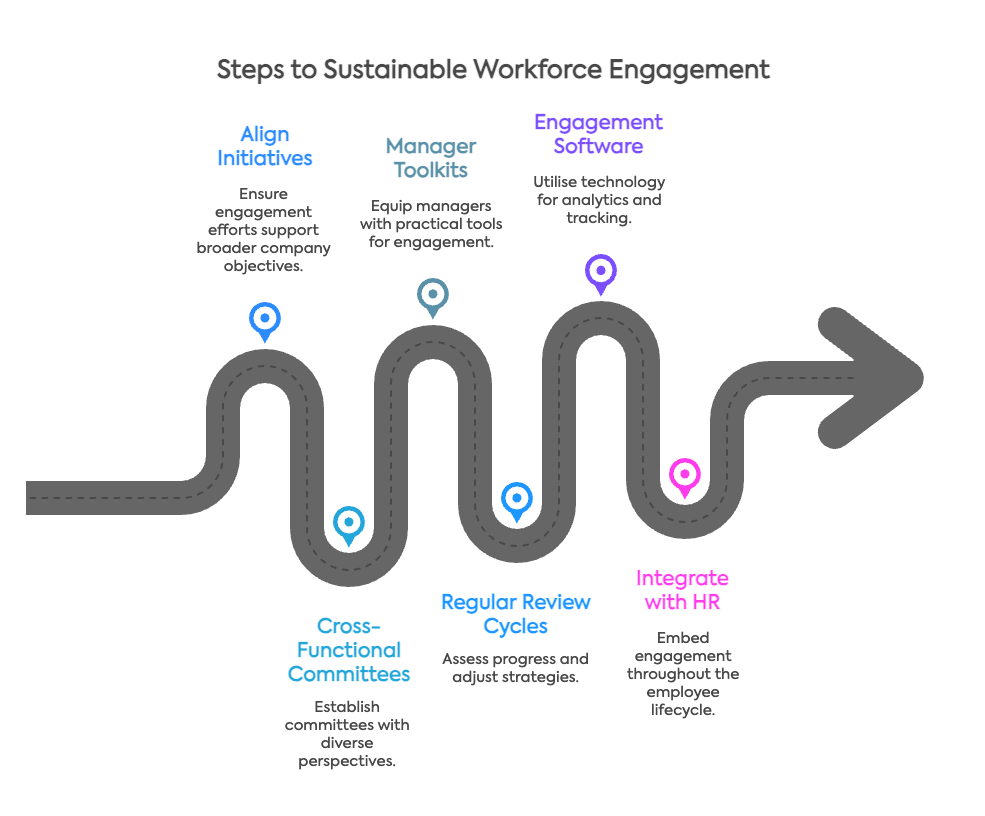HRIS system: complete guide to human resource information systems
Managing employee data shouldn’t feel like herding cats. Yet for many organisations, HR processes remain scattered across spreadsheets, filing...
Become the expert on delivering
valid and fair assessments for
your training and education.
Hire
|
Engage
|
Develop
|
|
Automatically match to candidates who are a great fit for your team culture and who are intrinsically motivated to succeed. |
Deeply understand your organisation with science-backed analytics on your culture, team design, and engagement. |
Back your onboarding, compliance and skill development with industry-leading credentialling, competency and capability expertise.
|
.png?width=383&height=200&name=team%20(1).png)
5 min read
 Mathan Allington
Jun 27, 2025 11:23:09 AM
Mathan Allington
Jun 27, 2025 11:23:09 AM

Table of Contents
Workforce engagement goes beyond feel-good initiatives and coffee catchups. It’s about creating a workplace where employees are genuinely connected to their roles, inspired by their team, and driven to achieve shared goals. Done well, it doesn’t just improve employee motivation; it directly impacts business performance. But many organisations still underestimate just how much engaged employees contribute to organisational success.
If you're a leader tasked with improving team performance or reducing turnover, you already know how critical workforce engagement is. But where do you start, and how do you ensure your initiatives actually work? This guide walks you through building an effective employee engagement strategy, measuring engagement, leveraging modern tools, and connecting the dots between engaged teams and better business outcomes.
At its core, workforce engagement is the emotional and professional connection employees feel towards their work and organisation. Engaged employees don’t just clock in for their paycheck; they go above and beyond because they believe in the company’s mission and value their role in achieving it.
An engaged workforce is the backbone of any thriving organisation.
Here’s why prioritising engagement is non-negotiable:

Companies that actively prioritise employee engagement strategies see tangible benefits, from higher revenue growth to cultural alignment. It’s clear that engagement isn’t a buzzword; it’s a business driver.
A strong employee engagement strategy doesn’t happen by accident. It’s shaped by understanding your employees' needs, leveraging the right tools, and creating space for consistent feedback. Importantly, it should align with the organisation’s culture and long-term goals.
To design an effective strategy, you need to first recognise what drives employee engagement. Here are the key elements:

To ensure a strategic approach, map out your employee engagement efforts as a continuous cycle:
The only way to improve is to measure. And the best way to measure? Using employee engagement surveys combined with engagement metrics that drill down into employee sentiment, satisfaction, and motivation.
Survey responses give you an unfiltered look into what’s working and where to focus your attention. Key questions include:
Collecting data regularly (e.g. monthly pulse surveys or annual surveys) ensures insights remain relevant and actionable.
Effective employee engagement surveys rely on consistent, science-backed methodology. Compono believes in an approach that uses fixed questions designed to generate quantitative data and insights, paired with qualitative feedback for a well-rounded view.
Unlike surveys where questions change month to month—resulting in inconsistent, low-quality data and feedback based on random ideas—Compono’s method ensures rigour and scientific validity. This approach provides actionable insights that go beyond surface-level feedback, driving meaningful improvement in employee engagement.
This is where employee engagement software makes life significantly easier. It allows organisations to:

Compono’s Engage platform, for example, connects survey feedback with tangible recommendations, helping HR leaders make data-driven decisions that improve engagement and long-term employee satisfaction. By integrating real-time feedback with cultural diagnostics, leaders can go beyond gut feeling and create engagement strategies designed for continuous improvement.
Selecting the right employee engagement software goes beyond simply gathering pulse surveys and engagement metrics. While tools like Culture Amp are great for providing surface-level insights, Compono takes it a step further by offering deeper cultural analysis and actionable insights tailored to your organisation.
When choosing software, consider features like advanced analytics, ease of use, and the ability to align engagement data with your company’s goals. Compono not only measures engagement, but also helps uncover the underlying factors shaping your workplace culture, empowering you to drive meaningful change and build a stronger, more connected team.
The ultimate question is simple: How does employee engagement directly influence business performance?
The answer lies in understanding that engagement touches every corner of an organisation. Here are some of the business outcomes closely tied to highly engaged workplaces:
Companies that succeed in improving engagement enjoy higher employee retention rates. Highly engaged employees are less likely to churn, which reduces recruitment costs and builds stronger internal teams over time.
Engaged employees don’t just meet expectations; they exceed them. They display discretionary effort by going the extra mile, contributing to better business outcomes and boosting the bottom line.
Engagement isn’t limited to internal teams. The knock-on effect leads to improved customer experiences. Motivated employees deliver thoughtful, consistent, and impactful interactions, which, in turn, wins over customers.

Offering meaningful development opportunities is one of the simplest ways to enhance both job satisfaction and productivity. Compono Develop, for example, ensures each employee has access to tailored, career-enhancing learning pathways. By automating development processes and ensuring seamless integration with HRIS tools, it’s easier than ever to invest in your team’s future.
When employees see a clear personal growth trajectory, they are:
By investing in your employees' growth, you not only improve retention rates, but also create a culture of continuous learning and improvement. This leads to higher employee engagement, productivity, and ultimately, business success.
Finally, it’s worth acknowledging that workforce engagement doesn’t just make happier employees. It directly impacts the customer experience, influencing how satisfied clients feel with your services. When teams are motivated, their interactions are characterised by effort, attentiveness, and care. And customers notice.
A well-engaged workforce leads to:
The connection here isn’t possible to ignore. If connected employees feel invested and engaged, your customers are more likely to walk away with positive perceptions.
Workforce engagement is far more than a metrics-based initiative; it’s the heartbeat of a thriving business. Fostering highly engaged workforces, delivering consistent development experiences, and measuring sentiment with the right employee feedback tools creates healthier workplaces the entire organisation can feel proud of.
If you’re ready to take control of workforce engagement:

If you’re ready to take control of workforce engagement, Compono can help you evaluate your teams and understand how their personalities impact collaboration. Speak with one of our experts today!

Managing employee data shouldn’t feel like herding cats. Yet for many organisations, HR processes remain scattered across spreadsheets, filing...

Here’s something that might surprise you: organisations with highly engaged employees see 23% higher profitability and 18% greater productivity. A...

Every organisation has a workplace culture—the question is whether it’s working for you or against you. Workplace culture is often referred to as...